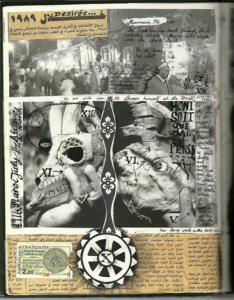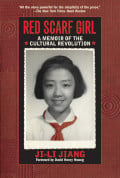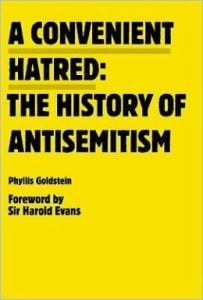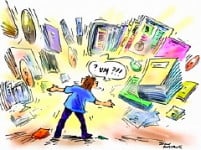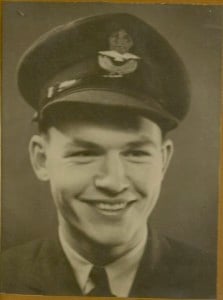[FA_Lite id="519"] [FA_Lite id="519"]
Resources of Resistance: Why Every Grade 10 History Teacher Should Teach About the Holocaust
Posted by Ben Gross on March 14, 2013
I am often asked why I would want to teach about genocide. What would possess me to spend so much time reading, talking, and thinking about some of the worst events in human history? My answer to this question has always been inspired by Wangari Maathai’s Story of the Hummingbird. Like many good stories, the way it is told varies. My delivery tends to be the following:
Topics: Facing History Resources, History, milgram, resistance, reflection
As mentioned in my previous post, doing professional development with Facing History has been a very transformative experience for me as an educator. Many teachers attend PDs, seminars and workshops, and quite often, there is not much follow-up afterward, but with Facing History, the staff ensures that they provide resources and follow-up with teachers attending their seminars.
Myra Novogrodsky, who connected with Facing History as a classroom teacher back in the early ‘80s, was just honoured with a Diamond Jubilee medal for her contributions in Ontario as a community organizer, writer, and mentor. Myra shared with Facing History one place where she found her inspiration as a teacher. Here’s what she had to say:
Topics: Holocaust Education, In the news
Michael Grover
Teacher
Scarborough Centre for Alternative Studies
Scarborough, ON
Topics: History, Strategies, Lesson Ideas, English Classroom
- A Convenient Hatred: The History of Antisemitism, by Phyllis Goldstein
This a wonderful resource from Facing History, but the fact that it is a Facing History resource is not the reason I include this book. Goldstein’s A Convenient Hatred provides a detailed explanation of the history of antisemitism and how it has adapted and persisted through time. This book has been an invaluable resource to me in helping to answer that recurring question: “Why did [they] hate Jewish people?” In fact, if I once had trouble answering that question, I now have troubling keeping my answer to that question to an accessible chunk.
As a classroom resource: the book is extensive in its purview of the subject and can be, as such, integrated into almost any history course (from ancient to modern studies). Moreover, being a Facing History publication, there are numerous resources available for using the book in the classroom. Of particular worth, I would advise taking a free online workshop associated with the text. The next begins March 15, 2013. - The Rape of Nanking: The Forgotten Holocaust of World War II, by Iris Chang
In The Rape of Nanking Iris Chang provides not only a detailed account of the events and their context, but she also offers a profound explanation for the motivation of the Japanese soldiers during the invasion of China. This book graphically details the horrors of human behaviour, broadens our understanding of World War II, demonstrates the effects of unchecked institutionalized discrimination, and details the politics of denial.
As a classroom resource: the writing is accessible intermediate academic and senior academic and applied readers. Of particular note for use in the classroom are Chang’s explanation of the profound effect of institutionalized discrimination on the behaviour of individuals (see “The Motives Behind Nanking,” pp. 54-59 and the classroom reading guide), and Chang’s address of the continued denial(see Chapter 10) of the event by the Japanese and the politics surrounding our ignorance of it in the West, a relevant theme to all discussions of genocide. The book includes graphic documents (primarily but not limited to photographs found between pages 146 and 147) of the atrocities that are incredibly thought provoking for mature students, but must be very carefully selected and reviewed with consideration to students’ capacity to deal with them (and the parents willingness to have them viewed by their children). It is worth noting that the stories and images Chang encountered while writing this book led her into increasingly deeper depression and, eventually, to suicide; this knowledge serves as a profound reminder that as we deal with human atrocities, we must consider and allow time to address our students’ own emotional reactions to these events. Iris Chang gives a historical overview and shares her insights into the Japanese military invasion of Nanking at http://vimeo.com/21218528.
- Extraordinary Evil: A Brief History of Genocide, by Barbara Coloroso
If Coloroso’s Extraordinary Evil can be described as reductionist in its approach to and description of genocide vis a vis bullying, it can nonetheless also be conceived of as a wonderful resource for teachers of genocide to help students connect with material that can be so difficult to conceptualize. Coloroso’s writing is accessible to high school students and the connections she makes are directly relevant to the school context. She makes a point of discussion and an argument for understanding how our actions matter, even on a small scale. She makes an excellent argument for the role of the upstander (Facing History defines an upstander as someone who takes a stand against injustice), and why that role is not one that should be conceived of as a contextual one, but rather a pervasive attitude and behaviour.
As a classroom resource: her discussion of the Bully Circle (pp. 83-84) is interesting and one that I have found helps students develop empathy. While few students can truly connect with the tragedy of a genocide, almost all students can relate to bullying. Having students make this connection (see page four of the activity attached for classroom application) through role play can be very effective, but, as always, we must know our class. If we suspect someone in the class is being bullied, having that person participate could be incredibly demeaning. Furthermore, in the consolidation of our role play, it would be good to emphasize that just because we can empathize with being bullied, does not mean we can (nor do we want students to) fully understand what it means to be a victim of a genocide. Role play is fun and develops empathy. Just make sure it remains role play! Coloroso’s website provides additional resources for discussing roles in bullying at KidsAreWorthIt.com. - War Without Mercy: Race and Power in the Pacific War, by John Dower
In War Without Mercy, Dower takes a close look at World War II and compares the nature of racism and warfare in the two primary theatres of the war: the European theatre and the Pacific theatre. In analyzing various data, he quickly notes that [for the Americans] the battles in the Pacific were far more brutal than those in Europe. Building on this, he argues that while in the European theatre there was a sense of shared humanity even between opposing soldiers, the racist attitudes that soldiers in both Japan and America were taught (and taught is the key word here) regarding the enemy heavily influenced the subsequent treatment of the enemy. Dower focuses on the media’s role (through songs, propaganda, cartoons, and film) and influence in propagating racist attitudes. Though the language of the text is at times a bit too academic for the applied classroom in which I teach, his discussion of the media’s influence over how we think and behave is an accessible and worthy topic to engage in the classroom.
As a classroom resource: while I find the text is a bit dense, Dower includes a wonderful section of very accessible graphic documents such as magazine cartoons that very clearly depict “The War in Western Eyes” and “The War in Japanese Eyes”(pp. 180-200). Students engage with these quickly and with facility, and the documents provide a wonderful opportunity to teach students Document Based Questions, an important skill to develop and an imperative for the AP classroom (see image guide handout for classroom use). As a springboard to further inquiry, there is a wealth of related documents readily available to review as well. In particular, Merrie Melodies / Loonie Toons’ "Censored Eleven" (see video guide handout for classroom use) provide a unique insight into how stereotypes and racist ideas are taught to even the youngest audiences, though one should use discretion in approaching these documents in the classroom. Always contract for a safe space, provide students with context, explain your purpose and allow sufficient time to debrief challenging materials. Also, be ready to provide victim voices and positive depictions to balance negative portrayals of any identity. Lastly, know your students and their parents. - Cognitive Surplus: How Technology Makes Consumers into Collaborators, by Clay Shirky
While Shirky’s Cognitive Surplus does not directly address the issues of genocide or discrimination, this text is a wonderful resource for transforming our students from passive recipients of information to active upstanders, and can guide us as teachers through this process. Shirky details how the rise of the computer and the internet in the 21st Century has dramatically changed how people engage media. His key point, as the title suggests, is that people have demonstrated a measurable change in their patterns as consumers, moving away from a model of passive recipients of media products (e.g. television) to one of active producers (an amusing example he points to is LOL Cats). Shirky lists several examples (moving beyond LOL Cats) of how this shift in the control of production means that as individuals, we now have more control to produce good than at any point in history.
As a classroom resource: the first example Shirky lists to this end is Ushahidi, a site whose name means ‘testimony’ or ‘witness’ in Swahili. This is a web based program that has relied on the contribution of volunteers to spread awareness of events. Designed during the social upheavals in Kenya in 2007-2008, Ushahidi demonstrated a huge influence over political behaviour, and was operated at an individual level (for further information see Texting Talk). Ushahidi is a wonderful example of how individuals can be upstanders, and how as upstanders they can effect change. Jumping off from Ushahidi, we can explore other Web 2.0 tools (such as Glogster, Prezi, Bubbl.us, etc.) to produce our own multimedia products, use social networking sites (such as Facebook, My Space, Google+, etc) and employ online publishing tools (Wordpress… ironic emoticon here) to effect social change. Other prominent examples of sites dedicated to the harnessing of positive collaborative power include Change.org, DonorsChoose.org and Kickstarter.com.
For a succinct review of the book, see Shirky’s TED Talk on Cognitive Surplus.
Topics: Books, Professional Development
My Grade 8 students love their smartphones and computers. One of the most important jobs I have is to teach my students how to "curate" what's out there. My 20 year old son who takes Advertising at OCAD taught me the new meaning of this old word. "Curate" conjures up visions of dusty museum cases and stuffed animals--right? Well, these have gone the way of the dodo, as have the old style museum exhibitions. You've seen the exciting new ways in which curators present information today, especially with the Royal Ontario Museum so close at hand. The new curators' challenge is to choose and organize what is out there to make the maximum impression on viewers bombarded by visual media. For us, that means teaching our students how not to drown in Google hits, how to separate the wheat from the chaff, and what sites are actually useful to them.
Topics: History, Middle School
Why Teachers should bring history out of the shoe box and on to “the wall”
Posted by Robert Flosman on February 5, 2013
After the success of our museum, the crowds have gone as have the newspapers. How do you keep the momentum? A class can’t host a museum every month. The answer is turning inward. If we ask our students to uncover their past, to the basements and the shoeboxes in their homes, we uncover the ultimate facing history project: That of uncovering their families’ role in Canadian History. So many 15 year olds know their grandparents for their Florida vacation homes and holiday gifts. Teachers need to push our students to dig deeper. All these stories can be revealed over dinner and a conversation. A simple phone call can reveal a new world for a student and a new appreciation of family and history. What are their stories? Did they serve? Did they engage in resistance activities? What was their war experience? My students asked these very questions, then gathered and documented these stories and artifacts to display on our Wall of Heroes; a dynamic museum being built in our school halls.
Each artifact on the wall (see example below), provides a picture of the both the grandparents and student (with mention that they attend our school), and a brief account of their grandparents’ exploits. While no artifact will tell the whole story, each opens a window into history and encourages us to stop and further explore the connections we have with each other and our history. Jeff wrote that his grandfather was instrumental in developing CAMP X; that he was not only friendly with James Bond’s Ian Fleming but also guarded Igor Guzenko. Igor Guzenko is the first lesson in any grade 10 Cold war unit...but now that man pictured in every Canadian textbook with the bag over his head; the man who heralded the beginning of the Cold War in Canada has new meaning and connection to the class (Those less impressed with that connection at least went to see Sky fall! ). In the same class, a young lady named Lindsay knew only her Polish Catholic roots. Yet after investigating further, her family turned out to be Jewish! Her family had to hide from the Nazis. Her grandmother will soon be a part of our Wall of Heroes .
Teachers, how many of our students’ grandparents, great grandparents, aunts and uncles have built this country’s history? A life revealed on the Wall of Heroes. Museums don’t have to come from New York. Every student’s family is a small window into the past. At our school, kids are coming from everywhere to tell their families’ tales. A simple plak, costing $11.99 from Staples, brings their history to life for a school and a community. For more information on how to proceed and see our online archive, visit genocide@waterdown and look under Wall of Heroes. Let’s get the museum started!
| WaterdownMuseumvandersootblog was born on Dec. 27, 1902 in Tilburg, The Netherlands. After completing his studies, he was drafted into the Dutch army. When German troops invaded Holland in May 1940, he was a captain and in charge of a heavy machinegun detachment. He experienced some of the bitterest fighting in defence of his country on the Grebbeberg Line. For this he was awarded the Commerative War Cross with bar, (Oorlogs-herinnerings kruis). Rather than languishing in Germany as a P.O.W., he went into hiding and joined the local resistance movement. Some of the initial sabotage consisted of destroying railroads, falsifying identity and ration cards but as the war progressed his group focused mainly on the rescue and returning of Allied pilots and aircrews. These activities were punishable by death. Both the governments of the U.S. and Britain awarded him certificates of gratitude and appreciation.
He is the great grandfather (Groot Opa) of current students S__________and J______ L___________. |
Topics: Assessment, project, Genocide and Crimes Against Humanities Course, Lesson Ideas
Identity and Othering in "The Absolutely True Diary of a Part-Time Indian"
Posted by Leah Mauer on February 4, 2013
I’m not sure if it’s fate, or the fact that I’m a news junkie, but it seems as though I can always find a connection between what I’m studying in my classes and the news. This past term was no different.
Topics: Books, Facing History Resources, videos, Lesson Ideas, English Classroom, Literature, English

